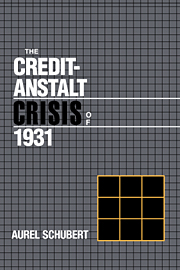Book contents
- Frontmatter
- Contents
- Tables
- Preface
- The Credit-Anstalt Crisis of 1931
- 1 Introduction
- 2 Diary of the crisis
- 3 Financial crisis theories and the Austrian experience of 1931
- 4 The causes of the financial crisis
- 5 The financial crisis and market efficiency
- 6 The financial crisis and economic activity
- 7 The financial crisis and the lender of last resort
- 8 Alternative policies and policy implications
- 9 Conclusions
- Bibliography
- Index
1 - Introduction
Published online by Cambridge University Press: 20 March 2010
- Frontmatter
- Contents
- Tables
- Preface
- The Credit-Anstalt Crisis of 1931
- 1 Introduction
- 2 Diary of the crisis
- 3 Financial crisis theories and the Austrian experience of 1931
- 4 The causes of the financial crisis
- 5 The financial crisis and market efficiency
- 6 The financial crisis and economic activity
- 7 The financial crisis and the lender of last resort
- 8 Alternative policies and policy implications
- 9 Conclusions
- Bibliography
- Index
Summary
Those who cannot remember the past are condemned to repeat it.
–George Santayana, 1905Recent economic developments have led to an increased interest in the interwar period and especially in the banking crises and panics of the 1930s. The threat of defaults of very large debtors or the possible consequences of a stock market crash, plus many other factors, have raised concerns about the stability of the financial systems of individual countries as well as the world. Despite the remarkable resilience the international financial system has shown on several occasions, worst-case scenarios have received considerable attention, some of them even predicting the recurrence of the Great Depression (Batra 1987) and reaping what has been most appropriately termed “the profit of doom” (Financial Times, December 4, 1988, V).
Over sixty years have passed since the Credit-Anstalt (CA) crisis, and banks still collapse. The late 1980s actually witnessed the largest numbers of bank failures since the days of the Great Depression, especially so in the United States. With more than 200 collapsed banks a new postdepression peak was reached in that country in 1988, following six consecutive years of record failures. It also marked the first year of a decline in the reserve fund of the Federal Deposit Insurance Corporation, which had been created as a consequence of the epidemic failures of the 1930s. The situation of the American banks worsened further in 1989 and 1990.
- Type
- Chapter
- Information
- The Credit-Anstalt Crisis of 1931 , pp. 1 - 6Publisher: Cambridge University PressPrint publication year: 1992



